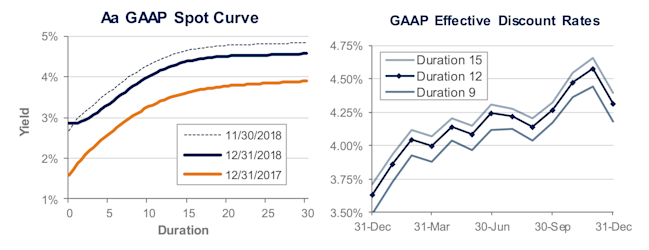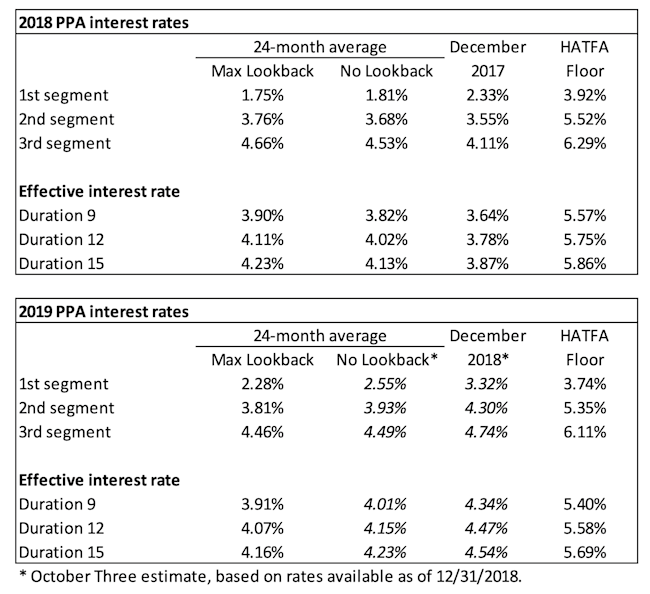December 2018 Pension Finance Update
December was the worst month for pensions in a decade, due to plunging stock markets and lower interest rates. Both model plans we track[1] gave back all 2018 gains to date and then some – Plan A lost 8% last month, ending 2018 down 1%, while the more conservative Plan B lost more than 2% in December, ending 2018 down almost 2%.
December was the worst month for pensions in a decade, due to plunging stock markets and lower interest rates. Both model plans we track[1] gave back all 2018 gains to date and then some – Plan A lost 8% last month, ending 2018 down 1%, while the more conservative Plan B lost more than 2% in December, ending 2018 down almost 2%:

Assets
Stocks got clobbered in December, ending 2018 in the red. The S&P 500 and NASDAQ fell 9%, the small-cap Russell 2000 lost 12%, and the overseas EAFE index dropped 6%. For the year, the NASDAQ lost 3%, the S&P 500 fell 4%, the Russell 2000 was down 11%, and the EAFE index lost 14%.
A diversified stock portfolio lost 9% in December and almost 8% for all of 2018.
Bonds gained 2%-3% last month, as Treasury rates fell 0.3%, while credit spreads increased modestly. For the year, a diversified bond portfolio lost 1%-4%, with long duration bonds and corporates doing worst.
Overall, our traditional 60/40 lost almost 5% in December and more than 5% for the year, while the conservative 20/80 portfolio was flat in December and down more than 4% for the year.
Liabilities
Pension liabilities (for funding, accounting, and de-risking purposes) are now driven by market interest rates. The graph on the left compares our Aa GAAP spot yield curve at December 31, 2017, and December 31, 2018, and it also shows the movement in the curve last month. The graph on the right shows our estimate of movements in effective GAAP discount rates for pension obligations of various duration during 2018:

Corporate bond yields fell 0.25% in December, pushing pension liabilities up 2%-4%. For the year, liabilities fell 3%-6%, with long duration plans seeing the biggest drops.
Summary
2018 was an impossible year for investors – all major asset classes lost money. Pension sponsors were cushioned from this experience to some extent by seeing a corresponding fall in the value of pension liabilities. Still, a 15% drop in stock prices in the fourth quarter obliterated what was a promising year for pension finances:

Looking Ahead
Congress passed a budget in 2015 that includes a third round of pension funding relief since 2012. The persistence of historically low interest rates, however, means that pension sponsors that have only made required contributions will see contributions ramp up in the next few years as the impact of relief fades (barring a continued surge in long-term rates).
Discount rates moved down last month. We expect most pension sponsors will use effective discount rates in the 4.0%-4.5% range to measure pension liabilities right now.
The table below summarizes rates that plan sponsors are required to use for IRS funding purposes for 2018, along with estimates for 2019. Pre-relief, both 24-month averages and December ‘spot’ rates, which are still required for some calculations, such as PBGC premiums, are also included.

[1]Plan A is a traditional plan (duration 12 at 5.5%) with a 60/40 asset allocation, while Plan B is a largely retired plan (duration 9 at 5.5%) with a 20/80 allocation with a greater emphasis on corporate and long-duration bonds. We assume overhead expenses of 1% of plan assets per year, and we assume the plans are 100% funded at the beginning of the year and ignore benefit accruals, contributions, and benefit payments in order to isolate the financial performance of plan assets versus liabilities.
